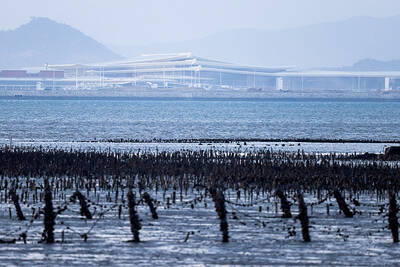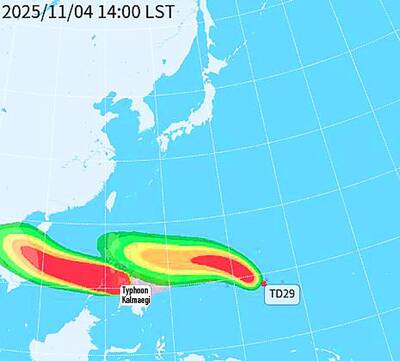The Navy celebrated the 63rd birthday of its oldest vessel -- the Guppy-class SS-791 Sea Lion submarine -- last Thursday.
The SS-791 was not only celebrating its 63rd birthday, but also its 34th year of service in the Navy. Along with the SS-792 Seal, the SS-791 is one of two existing "miracles" in the navy, as it is the oldest submarine still in service.
As part of the Mutual Defense Treaty between the US and the Republic of China (台美協防條約), in 1970 the US gave the SS-791 and SS-792 to the Taiwanese Navy -- after serving 28 years in the US Navy.

PHOTO: CNA
In 1973, Captain Kuan Chen-ching (
During the ceremony last Thursday, Rear Admiral Wang Hsi-ling (汪希苓), Taiwan's military attache to the US who oversaw the arrangement in the 1970s, officially accepted the two vessels on behalf of Taiwan.
With old piping, big knobs and rudders, old panels, limited space and the pervasive oil smell, the interior of the submarine is strikingly reminiscent of scenes from World War II movies. Sonars and torpedo systems complete the experience.
Among the 75 sailors on board, only the captain enjoys a private room -- and it is smaller than one ping. Everybody else, including the first officer, shares a public room for sleep. Regular meals are provided by a kitchen approximately two pings in size. It takes more than an hour for everybody on board to finish their meal as only 20 people can fit in the dining room at any given time.
With its 5,200 horsepower diesel engine, the SS-791 was initially capable of completing a non-stop 8,350km trip in approximately 45 days. Top speed under water was 12 knots and 16 knots on the surface.
A rumor that could have proven harmful to the navy's image and affect sailors' morale haunted the vessel since its acquisition, however. Some believed there was a real chance that after diving, the two Guppy-class subs would never resurface.
But SS-791 Warrant Officer Liu Tsai-hsin (劉財心) explained why the rumor never turned into reality.
"There is an air tank inside the vessel. When the submarine is on the surface, its entire weight is approximately 1,800 tonnes. When we need to dive, however, the air tank will take in 3,000 pounds [1,360kg] of air, turning the vessel into a 2,400-tonne rock. The system may be old, but it is reliable," Liu said.
Between 1944 and 1946, the US built 45 Tench-class submarines. Fourteen of those were upgraded to Guppy-class in 1950, including the SS-791.
Prior to joining the Taiwanese fleet, the SS-791 was known as the USS-478 Cutlass. It was built in the Portsmouth Naval Shipyard in Kittery, Main, and completed on Nov. 5, 1944.
The vessel was initially equipped with 10 torpedo launch tubes and sonar systems, with 11 officers and 70 petty officers and sailors.
But the US government's plan to help Taiwan's destroyer fleet conduct anti-submarine warfare resulted in the removal of all torpedo systems from the sub before it was handed over.
After it came into service, the Navy tried to restore its torpedo capability, but its indigenous system never reached optimal operability and the SS-791 was eventually allocated for training purposes.
The Navy's Fleet 256 chief of staff Rear Admiral Yang Yi (楊木益) believes the SS-791 can still make a contribution to the training of the Navy's next generation of officers.
"It is a tough environment for future naval officers to grow in. It is small, old and slow," Yang said. "But, the vessel itself is truly a legend."
Although it is the oldest submarine in service, many contemporary high-ranking naval officers have served on board the SS-791, including Minister of National Defense Lee Jye (李傑), Deputy General-Chief-of-Staff Admiral Wang Li-shen (王立申) and Deputy Commander-in-Chief of the Navy Lieutenant General Shen Po-chi (申伯之).
Lee was a lieutenant commander when the SS-791 was given to Taiwan and was also the first weapons chief on board the Sea Lion. He later became the third captain of the SS-791.
After new submarines are acquired by the Navy, the Ministry of National Defense will retire the SS-791 and the SS-792. Navy enthusiasts expect the two vessels will be restored after they retire and hope one will be used for training purposes at the Naval Academy while the other will be ported and turned into a museum.

Three Taiwanese airlines have prohibited passengers from packing Bluetooth earbuds and their charger cases in checked luggage. EVA Air and Uni Air said that Bluetooth earbuds and charger cases are categorized as portable electronic devices, which should be switched off if they are placed in checked luggage based on international aviation safety regulations. They must not be in standby or sleep mode. However, as charging would continue when earbuds are placed in the charger cases, which would contravene international aviation regulations, their cases must be carried as hand luggage, they said. Tigerair Taiwan said that earbud charger cases are equipped

Foreign travelers entering Taiwan on a short layover via Taiwan Taoyuan International Airport are receiving NT$600 gift vouchers from yesterday, the Tourism Administration said, adding that it hopes the incentive would boost tourism consumption at the airport. The program, which allows travelers holding non-Taiwan passports who enter the country during a layover of up to 24 hours to claim a voucher, aims to promote attractions at the airport, the agency said in a statement on Friday. To participate, travelers must sign up on the campaign Web site, the agency said. They can then present their passport and boarding pass for their connecting international

UNILATERAL MOVES: Officials have raised concerns that Beijing could try to exert economic control over Kinmen in a key development plan next year The Civil Aviation Administration (CAA) yesterday said that China has so far failed to provide any information about a new airport expected to open next year that is less than 10km from a Taiwanese airport, raising flight safety concerns. Xiamen Xiangan International Airport is only about 3km at its closest point from the islands in Kinmen County — the scene of on-off fighting during the Cold War — and construction work can be seen and heard clearly from the Taiwan side. In a written statement sent to Reuters, the CAA said that airports close to each other need detailed advanced

WEATHER Typhoon forming: CWA A tropical depression is expected to form into a typhoon as early as today, the Central Weather Administration (CWA) said yesterday, adding that the storm’s path remains uncertain. Before the weekend, it would move toward the Philippines, the agency said. Some time around Monday next week, it might reach a turning point, either veering north toward waters east of Taiwan or continuing westward across the Philippines, the CWA said. Meanwhile, the eye of Typhoon Kalmaegi was 1,310km south-southeast of Oluanpi (鵝鑾鼻), Taiwan’s southernmost point, as of 2am yesterday, it said. The storm is forecast to move through central